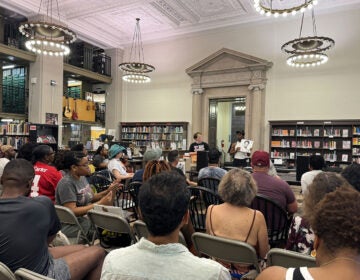Space exploration: Matching theater companies, venues
It may be that “all the world’s a stage”–as per Shakespeare–but in Philadelphia, many theater companies are scrambling to find good stages. The shortage is spurring theater companies to try some unusual spaces.
Recently a few theater producers were invited to ponder using the Philadelphia Zoo as a stage. Charlotte Ford poked through the tropical aviary and the gorilla playpens, and started dreaming of a story that might involve people in cages.
“Like having people in an office exhibit–showing humans in their natural habitat,” said the writer/actor behind the Fringe hits “Flesh and Blood and Fish and Fowl” and “Chicken.”
“Could be something interesting there,” she said.
The animals in the zoo display a theatricality of their own, particularly when there’s food or sex on the line. Humans may or may not have the same reasons for the dramatic gesture, but animals do it better.
“There’s this rule that you should never have children or animals on stage, because that’s the only thing people will watch,” said Ford. “They are so effortlessly present–as opposed to actors who are trying to appear that they are in the present moment.”
It’s not just a stage
Theater people can be very specific about their staging needs. Some require a space with, for example, a stage. One of a certain shape, with risers for audience seating, enough power for spotlights and a ceiling grid on which to hang them.
There are more theater companies in Philadelphia than appropriate spaces to accommodate them. Last November, the Greater Philadelphia Cultural Alliance launched SpaceFinder, an online database of theater venues. It currently lists 185, with descriptions of their size, location and technical specs.
Some of those are not stages so much as big rooms with folding chairs. Some of them don’t have necessary facilities.
“I’m shocked to discover how few of them have bathrooms available to the artists during performance,” said Seth Rozin of the Interact Theater Company. “Pretty critical when you think about it. If you have to share a bathroom with the audience you’re compromising the whole illusion of separation of art from audience. Nothing breaks it like a bathroom.”
Rozin found a regular home for Interact at the Adrienne Theater in Rittenhouse Square, a building with three stages of different sizes and capabilities. He recently converted the top floor of the Adrienne into a fourth performance space. Proving how hungry local theater companies are for good spaces, it booked up for the season before it officially opened.
To improve the ratio of theater companies to available spaces, another matchmaking service is in the works.
Uniting performers and churches
The Partners for Sacred Places and CultureWorks are studying how to connect performers with area churches. There could be an ideal synergy allowing actors into large, open churches with high ceilings that could use the love and elbow grease of a scrappy theater company. But there are some challenges to overcome.
The Broad Street Ministry uses a church at Broad and Spruce streets that was built in 1900. The local theater company Inis Nua is staging a comedy called “Dublin by Lamplight,” about a down-and-out theater company circa 1904. So the setting is perfect. The building is a little worse for wear, but that also suits the impoverished characters.
The back room of the Broad Street Ministry is like a cube: about 30 feet wide by about 30 feet long by about 30 feet high. The whole thing is ringed with doors, many with broken panes of glass.
“For whatever reason, in farce people need to open and close doors a lot,” said Inis Nua artistic director Tom Reing. “That’s where hilarity ensues.”
The space is perfect for the story, but makes it hard to produce it here. It’s wired for neither lights nor sound–power in general is shaky. The company cannot leave its set up, because the ministry needs to space during the day.
“It’s not known as a performance space. It’s known as a church,” said Reing. “Our job is to let audiences know where we are at, and to work with the Broad Street Ministry so that we are aiding them, not being a burden.”
The ministry has an arts marshal on staff. His name is Liam O’Donnell, who approaches the Partners for Sacred Places study with caution. There are issues to iron out: how much the space can be altered, how much access to give the company and, most importantly, how it will further the mission of the church. He doesn’t want his church to be a space-for-hire.
“The system of exchange doesn’t move us as a community,” said O’Donnell. “We don’t want only an exchange of money for services. We want a relationship.”
Inis Nua is game for it–it will host some theater workshops with the ministry. But after the play closes, it probably will not return. Chances are slim that Inis Nua will produce another story about impoverished actors set in a ramshackle theater circa 1900.
WHYY is your source for fact-based, in-depth journalism and information. As a nonprofit organization, we rely on financial support from readers like you. Please give today.




